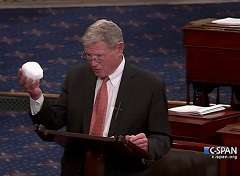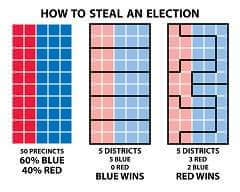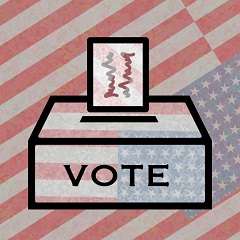FEBRUARY 26, 2015
FEBRUARY 26, 2018
3 Years Ago, We All Laughed at James Inhofe’s Snowball. The Joke Was on Us.
2021?
Summer 2021 Was Hottest on Record in the Contiguous U.S., NOAA Says
Electoral College?
The Uniquely Dangerous Movement to End the Electoral College
By JIM INHOFE & TRENT ENGLAND December 13, 2021 6:30 AM
“The National Popular Vote Interstate Compact is an existential threat to our republic — and its supporters are getting closer to success.”
National Popular Vote Interstate Compact you ask?
Agreement Among the States to Elect the President by National Popular Vote
“The National Popular Vote Interstate Compact will guarantee the Presidency to the candidate who receives the most popular votes across all 50 states and the District of Columbia. The Compact ensures that every vote, in every state, will matter in every presidential election. The Compact is a state-based approach that preserves the Electoral College, state control of elections, and the power of the states to control how the President is elected.”
“Over the years we have witnessed a reliable pattern develop in American politics: When the Left loses, instead of changing its arguments or its candidates it opts to change the rules. When Democrats lost the White House and President Trump filled three vacancies on the Supreme Court, they called for packing the Court. When they failed to win a large enough majority to advance their radical agenda in the Senate, they called for abolishing the filibuster. And perhaps most insidiously, after losing presidential elections, they have set their sights on scrapping the Electoral College.”
I am not a Democrat. I have never voted in a Democratic Primary. I voted for Reagan in 1980. I have been wanting the Electoral College abolished since I was in the 6th grade in 1972. I wrote a paper about it in the 8th grade in 1974.
“President Trump filled three vacancies on the Supreme Court”
You gloss over Mitch McConnell using two different standards of ethics. Can we say Merrick Garland?
“they called for abolishing the filibuster”
The History of the Filibuster
“Editor’s Note: In testimony before the U.S. Senate Committee on Rules and Administration, Sarah Binder counters a number of conventionally held notions about the origins and history of the Senate filibuster. Binder notes that the filibuster was not part of the original design of the Senate and the creation of the cloture rule was not a statement of the Senate’s love for supermajority rules, but rather the product of hard-nose bargaining with an obstructive minority.“
HISTORY.COM:
Filibuster
“The loophole that permits a senator’s right to speak endlessly on the senate floor dates to Vice President Aaron Burr, who declared in 1805 that the Senate need not be burdened by too many procedural rules. Back then a process to end debate on legislation, known as the “previous question” motion, was rarely used, so upon Burr’s recommendation, the senate dropped it in 1806.
Minority party senators soon figured out that talking endlessly on the Senate floor could prolong debate indefinitely and gum up progress on a bill or nomination. The first successful filibuster was recorded in 1837, when a group of Whig senators who opposed President Andrew Jackson filibustered to prevent Jackson’s allies from expunging a resolution of censure against him.”
Is the Filibuster Unconstitutional?
“The answer, however, isn’t quite so clear. While many people might assume that the filibuster is provided for in the Constitution, that document doesn’t refer in any way to the tactic. The first Congresses did not have nor recognize a filibuster. Senators had the option of invoking a “previous question” motion, which by majority vote would end debate on whatever topic was being discussed. When that type of motion was eliminated in 1806, the reform wasn’t intended to create the filibuster; it was, instead, instigated by the presiding officer of the Senate who thought the previous question motion wasn’t needed in a house comprised of “gentlemen” who’d know when to move on. According to one historian of the filibuster, “Far from being a matter of high principle, the filibuster appears to be nothing more than an unforeseen and unintended consequence” of this house-keeping revision of the Senate rules.”
“And perhaps most insidiously, after losing presidential elections, they have set their sights on scrapping the Electoral College”

Presidents Elected Without Winning the Popular Vote
“Five U.S. presidents have taken office without winning the popular vote. In other words, they did not receive a plurality regarding the popular vote. They were elected, instead, by the Electoral College—or in the case of John Quincy Adams, by the House of Representatives after a tie in the electoral votes. They were:
- Donald J. Trump, who lost by 2.9 million votes to Hillary Clinton in the 2016 election
- George W. Bush, who lost by 543,816 votes to Al Gore in the 2000 election
- Benjamin Harrison, who lost by 95,713 votes to Grover Cleveland in 1888
- Rutherford B. Hayes, who lost by 264,292 votes to Samuel J. Tilden in 1876
- John Quincy Adams, who lost by 44,804 votes to Andrew Jackson in 1824″
“In 2006, frustrated Al Gore supporters, still fuming from his close loss to George W. Bush six years prior, launched the National Popular Vote Interstate Compact (NPVIC), a voluntary agreement among states to award their electoral votes to the winner of the national popular vote. The NPVIC is designed to go into effect once its signatory states comprise an absolute majority of all electoral votes (EV) — 270 EV, under the current map. Ten left-leaning states initially signed on, including California, Illinois, and New York, and five more blue states joined them after 2016. The plan is now nearly three-quarters of the way to taking effect, and in Michigan its supporters are currently gathering the signatures needed to put it on the ballot next year. While it suffered a major setback with Republican Glenn Youngkin’s win in the Virginia governor’s race, the NPVIC is coming closer and closer to fruition, making our efforts to oppose it more vital than ever.”
https://www.nationalpopularvote.com/state/mi
National Popular Vote: A Status Update
“Right now, it has been passed in 16 jurisdictions totaling 196 Electoral College votes, which is 72.6 percent of the 270 votes needed to give the compact legal force. This means that states totaling at least 74 more electoral votes have to pass the NPVIC in order for it to go into effect — votes totaling 36.4 percent of the Electoral College. According to the National Popular Vote website,
“The bill is a constitutionally conservative, state-based approach that preserves the Electoral College, state control of elections, and the power of the states to control how the President is elected. Under the current system, a voter has a direct voice in electing only the small number of presidential electors to which their state is entitled. Under NPV, every voter directly elects 270+ electors.”“

Status of the compact by state
“NPVIC supporters’ aim is to eliminate the Electoral College without doing the hard work of amending the Constitution. The Compact requires states to choose presidential electors based not on their state popular vote, but on the national popular vote. This sounds simple, but the devil is in the details. Each NPVIC-signatory state would determine the national popular vote on its own. That means a single official in each state would decide what votes to count from every other state. In a world of perfect peace and harmony, that might work. But American politics is not a world of perfect peace and harmony.”
Let’s look at this argument,
“Each NPVIC-signatory state would determine the national popular vote on its own.“
Text of the National Popular Vote Compact Bill
Reading is Fundamental!
“Prior to the time set by law for the meeting and voting by the presidential electors, the chief election official of each member state shall determine the number of votes for each presidential slate in each State of the United States and in the District of Columbia in which votes have been cast in a statewide popular election and shall add such votes together to produce a “national popular vote total” for each presidential slate.
The chief election official of each member state shall designate the presidential slate with the largest national popular vote total as the “national popular vote winner.”“
The States’ Chief Election Official will COUNT the VOTES and then they will be ADDED together. No, each state is NOT determining the popular winner on their own. Read the last sentence above for comprehension. Each state will name the winner of the votes added up together as their state’s winner.
“What’s more, even if it were — even if the potential for partisan abuse were never realized — the NPVIC would still dramatically increase the power of big cities at the expense of the rest of America. Without the Electoral College, our national elections would become a coastal affair. Just nine states — including the liberal bastions of New York, Illinois, and California — make up more than 50 percent of our population. The NPVIC would strip away the voices of Oklahomans, North Dakotans, Alaskans, Arizonans, and many others. Some Democrats see this as a feature of the plan, not a bug.:
Let me break down this disinformation.
“Without the Electoral College, our national elections would become a coastal affair.”
This is an oft-repeated Pro-Electoral College argument with no basis in fact or reality.
“Just nine states — including the liberal bastions of New York, Illinois, and California — make up more than 50 percent of our population.”
I grew up reading the World Almanac and Book of Facts. Mom would buy me one every year for Christmas since I was 8 years old. It contains the US Census.
The 50 US States Ranked By Population
331,318,992 total counting all 50 states and Washington, DC
States 1 to 9,
- California 39,937,489
- Texas 29,472,295
- Florida 21,992,985
- New York 19,440,469
- Pennsylvania 12,820,878
- Illinois 12,659,682
- Ohio 11,747,694
- Georgia 10,736,059
- North Carolina 10,611,862
is 169,419,413 (51%). That leaves 41 states for the other 49% of the votes.
“The NPVIC would strip away the voices of Oklahomans, North Dakotans, Alaskans, Arizonans, and many others“
The Electoral College stripped away those state voices (with the exception of Arizona) years ago.

Map of General-Election Campaign Events and TV Ad Spending by 2020 Presidential Candidates

12 states have received 96% of the 2020 general-election campaign events (204 of 212) by the major-party presidential and vice-presidential candidates (August 28 to November 3, 2020).
All of the 212 events were in just 17 states, meaning that 33 states and the District of Columbia did not receive any general-election campaign events at all.”

“TV Ad Spending Is Similarly Concentrated in a Dozen or So Closely Divided Battleground States
Seven out of eight dollars for TV ads up to mid-October ($884,000,000 of $1,015,000,000) were spent in the same 6 states. The map below shows TV ad spending (in millions) by state, as reported by NPR up to mid-October.”

“The NPVIC would strip away the voices of Oklahomans, North Dakotans, Alaskans, Arizonans, and many others“
2020 Presidential Candidate General Election Events Tracker (maintained by FairVote, Nov Version)
Oklahoma? North Dakota? Alaska? Zero (0) Candidate visits during 2020 Campaign:




“The Constitution reserves nearly all the power over elections to the states. It requires state legislatures to determine how best to represent their state in the Electoral College. It bars federal officials from serving as presidential electors. The Electoral Counts Act of 1887 reiterates this constitutional design by limiting federal power to interfere in states’ electoral-vote counting — no matter how good the intentions or real the concerns of members of Congress.”
Nothing in the NPVIC goes against this. States approve NPVIC. States choose who POTUS is.
From earlier in the op-ed:
“But American politics is not a world of perfect peace and harmony.“
Faithless Electors was Donald Trump’s plan to stage his “Big Lie” Coup:
Please explain the paragraph above to your fellow GOP legislators,
“The United States is hardly alone in using a two-step democratic process to choose our national executive. Parliamentary systems work that way, and Germany and India have their own unique electoral-college systems. Requiring concurrent victories across multiple states or districts forces presidential candidates to appeal to the broadest possible cross-section of the electorate, which in turn ensures a government that reflects the diversity of its constituents.”
Germany’s process has nothing to do with an electoral-college system or multiple states or districts.
How Germany chooses its chancellor
“Once it’s clear with whom the party that has won the most seats will establish a coalition, negotiations to draft a coalition agreement, the basis of the new government, can begin. The agreement lays down the new government’s plans for the four-year term. And in these talks, the coalition partners name: who they want to be chancellor and who they want to hold which positions in the cabinet.
Next, the 600-plus members of the newly elected Bundestag hold their first session and vote for the next chancellor in a secret ballot. It’s up to the President to suggest a candidate when the Bundestag convenes for the first time. He is not obliged to suggest the person the parties may have singled out in coalition talks, but he must present a candidate who has a reasonable chance of being voted in.
If that person receives an absolute majority in the first round of voting, the president must declare him or her chancellor.”
You seem to be as well-versed on India’s election process as you Climate Change:


The Party holding the majority chooses the Prime Minister. NO “Electoral College” process or “by states”.
“Our great American Founders knew what they were doing in constructing a system of government that delicately balances power between cities and rural communities, between coastal communities and inland regions. The Electoral College is a critical part of that system, a guarantee that while political candidates may treat states such as Oklahoma as flyover country, Oklahomans will have as clear and powerful a voice in electing presidents as San Franciscans and New Yorkers. The very future of our republic depends on its preservation”
Your closing paragraph has no basis in fact or reality. I have already shown how Oklahoma had zero (0) campaign stops by any POTUS or VP candidate in 2020 Campaign. A handful of states (none of them Oklahoma) determine our president every four years.
Presidential battleground states, 2020
I live in a Red State. I voted ‘Red’ from 1980 until 2020 when I voted for me.
I want MY vote to COUNT. Living in a solid Red State, it does not matter who I vote for our even if I vote. This may be a reason for low voter turnout in states where people might feel their vote doesn’t matter?





